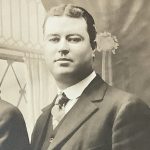Sepia Saturday 527. Fifth in a series about Albert Barney Charboneau — my paternal grandfather’s brother who died in the Great Influenza Pandemic of 1918.

By the time my dad’s Uncle Albert settled in Dolgeville, N.Y. in 1908, German immigrant Alfred Dolge — the piano and felt maker for whom the town was renamed — had been ganged up on by his fellow capitalists and driven out of New York State.
Why? Because although Dolge, like them, amassed his profit from workers’ labor, he also partially embraced the socialist ideology that was gaining ground in his native Saxony — and he instituted a number of worker benefit programs that the more ruthless Mohawk Valley capitalists could not abide.

Dolge inspires U.S. Social Security system
These are ably summed up in a 1975 article by Marion C. Mang, written when she was the Oppenheim, N.Y., town historian.
Inspired by his early readings of Liebnecht, Marx, Mill and Adam Smith, Dolge Instituted at Dolgeville a form of what we now call social security in his attempt to create an idealistic socialistic utopia.
About 1876 when the factory was first well established, Dolge began to set up his Pension Plan which remained almost exactly the same throughout his tenure. It was extremely generous, ranging from 50 percent of wages for disability after 10 years service up to 100 percent after 25 years.
Later he added a system of life insurance paid for by the firm and finally by an intricate system of bookkeeping, a program of Earning-Sharing whereby, an employee received a portion of the earnings according to his contribution in brains or the value of his work. This was not to be turned over until retirement, but was to be reinvested.
Dolge’s pension scheme served as a model for the U.S. Social Security system that retirees benefit from today — and his gain-sharing and life insurance plans were also groundbreaking.
Dolgeville’s population explosion
So it’s no wonder that workers from Germany — as well those from upstate New York and elsewhere — made a beeline to Dolgeville and ballooned its population from 300 to more than 2,000 in the late 1800s.

According to Mang, the Dolge factory complex, established to produce felt for the piano industry, expanded to make felt shoes, autoharps, piano cases and sounding boards, piano hammers — and even operate a lumber yard. And Dolge’s social innovations did not stop at the factory gate, either.
He paid workers to build railroads, lay out the town, install a municipal electric system (the first in an upstate New York town), construct a water and sewer system and built two schools (which launched the state’s first kindergarten). Dolge also established a fire department, a free library, a concert hall, a gymnasium, public parks and a newspaper.
Dolge departs, but his legacy remains
Despite his many innovations, Dolge was forced to depart on 1 May 1899 after a coterie of capitalists and bankers called in his loans — alarmed, no doubt, by what the workers in their own enterprises might demand if word got out.

Yet his legacy lives on. A bust of Dolge, erected in 1948, graces the walkway in front of the Dolgeville Town Hall. The Dolge Factory Complex is on the National Register of Historic Places.
And episodes of his life have been dramatized during Dolgeville’s annual Violet Festival by appreciative townspeople who have not forgotten the man whose enterprises channeled the energy and labor of their forbears to put Dolgeville on the map.
And with that, we will return next week to the story of my paternal grandfather’s brother — Albert Barney Charboneau — who continued his lumber career upon arrival in Dolgeville, N.Y., a decade after Dolge’s departure.
Please stop back! Meanwhile, please visit the blogs of this week’s other Sepia Saturday participants here.
© 2020 Molly Charboneau. All rights reserved.
